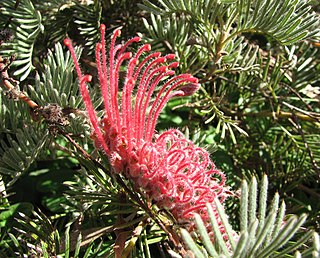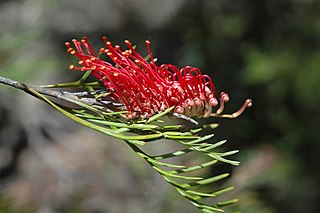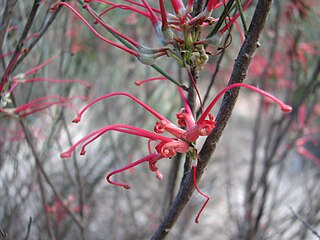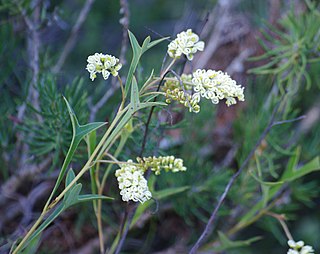
Grevillea petrophiloides, commonly known as pink pokers, rock grevillea or poker grevillea, is a species of flowering plant in the family Proteaceae and is endemic to the south-west of Western Australia. It is an erect shrub with divided leaves, the lobes mostly linear, and cylindrical clusters of usually pink to reddish pink and bluish-grey flowers.

Grevillea vestita is species of flowering plant in the family Proteaceae and is endemic to the south-west of Western Australia. It is an erect, spreading, prickly shrub with lobed leaves, the number and arrangement of lobes depending on subspecies, and more or less spherical to dome-shaped clusters of hairy, white to cream-coloured flowers sometimes tinged with pink.

Grevillea tetragonoloba is species of flowering plant in the family Proteaceae and is endemic to the southwest of Western Australia. It is a dense, erect to spreading shrub, usually with pinnatipartite to almost pinnatisect leaves, the end lobes linear, and clusters of yellowish-brown to fawn flowers with a scarlet to orange-red style.

Grevillea thyrsoides is a species of flowering plant in the family Proteaceae, and is endemic to the southwest of Western Australia. It is a small, spreading or low-lying shrub, with pinnatisect to comb-like leaves, the end lobes linear, and clusters of hairy pinkish-red flowers.

Grevillea asparagoides is a species of flowering plant in the family Proteaceae and is endemic to the south-west of Western Australia. It is dense, prickly shrub with deeply divided leaves, the end lobes linear and sharply pointed, and pink to reddish flowers with red styles.

Grevillea pilosa is a species of flowering plant in the family Proteaceae and is endemic to the south-west of Western Australia. It is a spreading to prostrate shrub with wedge-shaped to oblong leaves with sharply pointed, more or less triangular teeth or lobes, and clusters of pale pink to rose-pink or red flowers.

Grevillea concinna, commonly known as red combs or elegant grevillea, is a species of flowering plant in the family Proteaceae and is endemic to the south-west of Western Australia. It is a spreading to erect shrub with mostly linear to narrow wedge-shaped leaves sometimes with a sharp point on the tip. Flower colour varies with subspecies.

Grevillea didymobotrya is a species of flowering plant in the family Proteaceae and is endemic to the south-west of Western Australia. It is an erect shrub with simple leaves, the size and shape depending on subspecies, and cylindrical groups of yellow or cream-coloured flowers.

Grevillea hookeriana, commonly known as red toothbrushes or Hooker's grevillea, is a species of flowering plant in the family Proteaceae and is endemic to the south-west of Western Australia. It is a spreading to erect shrub, usually with linear leaves or deeply divided leaves with linear lobes, and toothbrush-shaped groups of red, black or yellowish green flowers, the style maroon to black.

Grevillea sarissa, commonly known as wheel grevillea, is a species of flowering plant in the family Proteaceae and is native to South Australia and Western Australia. It is a spreading shrub, usually with linear leaves, and more or less erect, wheel-like to more or less spherical clusters of red or yellow flowers.

Grevillea agrifolia, the blue grevillea, is a species of flowering plant in the family Proteaceae and is native to the north of Western Australia and parts of the Northern Territory. It is a shrub or tree with narrowly oblong leaves with the narrower end towards the base, and creamy-yellow flowers.

Grevillea synapheae, commonly known as catkin grevillea, is species of flowering plant in the family Proteaceae and is endemic to the southwest of Western Australia. It is a prostrate to erect shrub usually with divided leaves with 3 to 7 triangular to more or less linear lobes, and clusters of white to creamy yellow flowers.

Grevillea plurijuga is a species of flowering plant in the family Proteaceae and is endemic to southern Western Australia. It is a prostrate to low-lying or dense mounded to erect shrub with divided leaves with linear lobes and loose clusters of hairy, red or pink flowers.
Grevillea nematophylla, commonly known as water bush or silver-leaved water bush, is a species of flowering plant in the family Proteaceae and is endemic to Australia. It is shrub or small tree with simple or pinnatisect leaves, the leaves or lobes linear, and branched, cylindrical clusters of cream-coloured flowers.

Grevillea amplexans is a species of flowering plant in the family Proteaceae and is endemic to the Mid West region of Western Australia. It is a spreading shrub with arching branches, stem-clasping, sharply-pointed, lobed or toothed leaves and white to cream-coloured flowers.

Grevillea manglesioides is a species of flowering plant in the family Proteaceae and is endemic to the south-west of Western Australia. It is a spreading shrub usually with wedge-shaped leaves with lobed ends, and toothbrush-shaped clusters of flowers, the colour varying with subspecies.

Grevillea patentiloba is a species of flowering plant in the family Proteaceae and is endemic to the south-west of Western Australia. It is a prostrate to erect, spreading to straggling shrub with divided leaves, and down-turned clusters of red to deep pink and cream-coloured to bright yellow flowers with a red to deep pink style.

Grevillea pyramidalis, commonly known as the caustic bush, is a species of flowering plant in the family Proteaceae and is endemic to north-western Australia. It is an erect, spindly shrub or small tree with simple linear or pinnatisect leaves with linear to narrowly egg-shaped lobes, and white to yellow or cream-coloured flowers.

Isopogon scabriusculus is a species of flowering plant in the family Proteaceae and is endemic to southwestern Western Australia. It is a shrub with cylindrical, or narrow flat, sometimes forked leaves, and spherical to oval heads of pink or red flowers.

Grevillea neorigida is a species of flowering plant in the family Proteaceae and is endemic to Western Australia. It is compact, spreading shrub with deeply-divided leaves, the end lobes linear and somewhat sharply-pointed, and clusters of creamy-brown to off-white flowers with a scarlet or orange-red style.




















